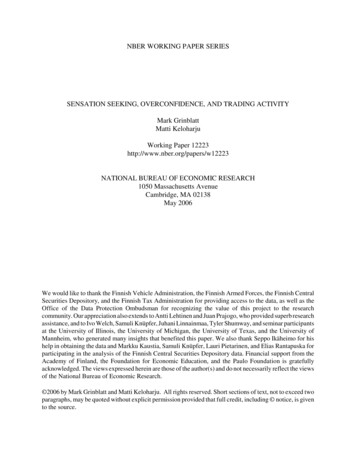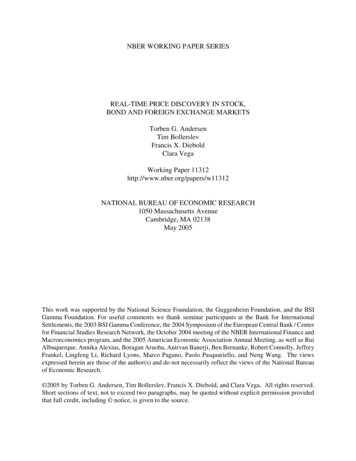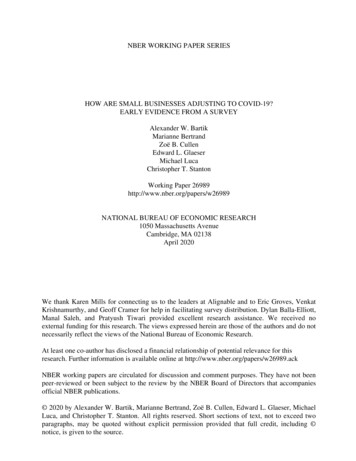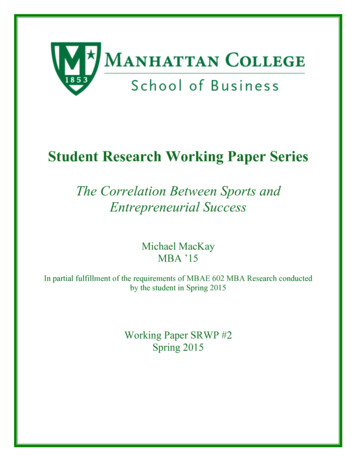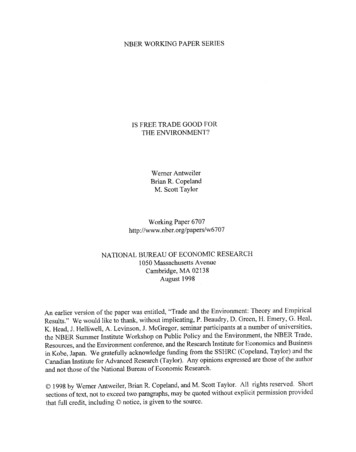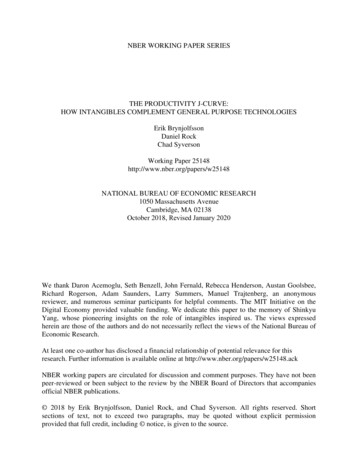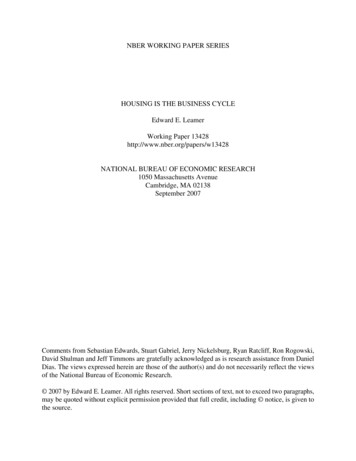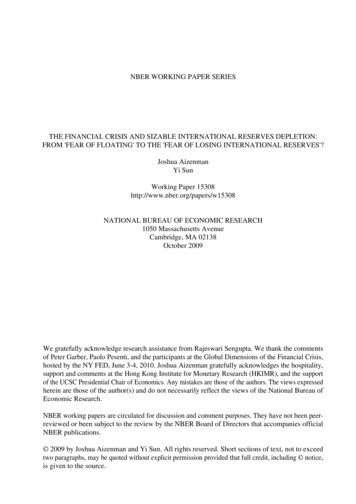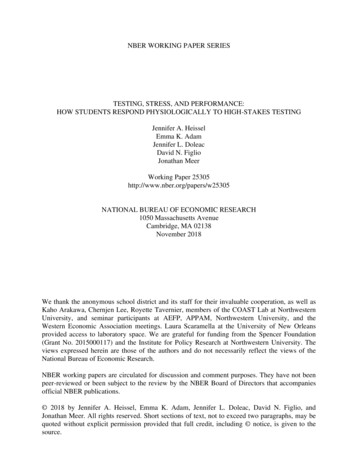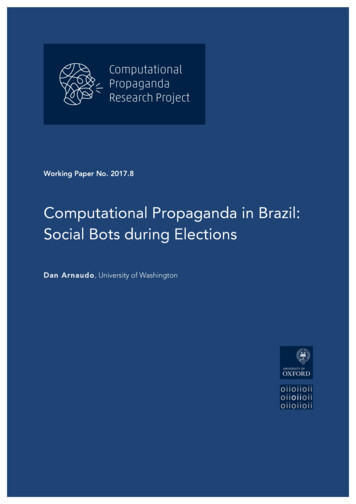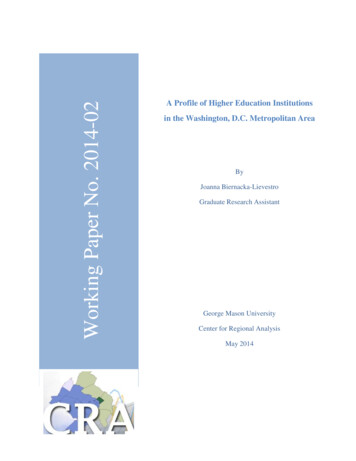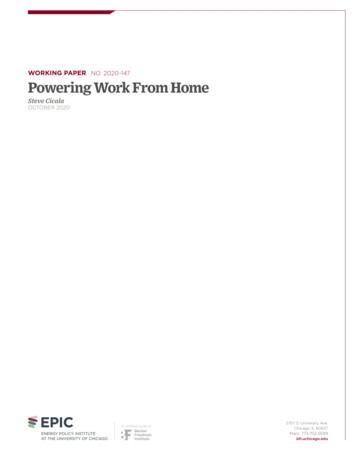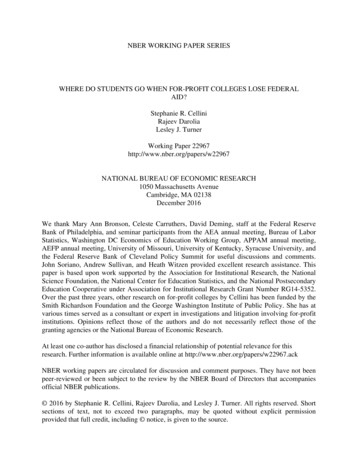
Transcription
NBER WORKING PAPER SERIESWHERE DO STUDENTS GO WHEN FOR-PROFIT COLLEGES LOSE FEDERALAID?Stephanie R. CelliniRajeev DaroliaLesley J. TurnerWorking Paper 22967http://www.nber.org/papers/w22967NATIONAL BUREAU OF ECONOMIC RESEARCH1050 Massachusetts AvenueCambridge, MA 02138December 2016We thank Mary Ann Bronson, Celeste Carruthers, David Deming, staff at the Federal ReserveBank of Philadelphia, and seminar participants from the AEA annual meeting, Bureau of LaborStatistics, Washington DC Economics of Education Working Group, APPAM annual meeting,AEFP annual meeting, University of Missouri, University of Kentucky, Syracuse University, andthe Federal Reserve Bank of Cleveland Policy Summit for useful discussions and comments.John Soriano, Andrew Sullivan, and Heath Witzen provided excellent research assistance. Thispaper is based upon work supported by the Association for Institutional Research, the NationalScience Foundation, the National Center for Education Statistics, and the National PostsecondaryEducation Cooperative under Association for Institutional Research Grant Number RG14-5352.Over the past three years, other research on for-profit colleges by Cellini has been funded by theSmith Richardson Foundation and the George Washington Institute of Public Policy. She has atvarious times served as a consultant or expert in investigations and litigation involving for-profitinstitutions. Opinions reflect those of the authors and do not necessarily reflect those of thegranting agencies or the National Bureau of Economic Research.At least one co-author has disclosed a financial relationship of potential relevance for thisresearch. Further information is available online at http://www.nber.org/papers/w22967.ackNBER working papers are circulated for discussion and comment purposes. They have not beenpeer-reviewed or been subject to the review by the NBER Board of Directors that accompaniesofficial NBER publications. 2016 by Stephanie R. Cellini, Rajeev Darolia, and Lesley J. Turner. All rights reserved. Shortsections of text, not to exceed two paragraphs, may be quoted without explicit permissionprovided that full credit, including notice, is given to the source.
Where Do Students Go when For-Profit Colleges Lose Federal Aid?Stephanie R. Cellini, Rajeev Darolia, and Lesley J. TurnerNBER Working Paper No. 22967December 2016JEL No. H52,I22,I23,I28ABSTRACTRecent policy debates have focused on whether restricting for-profit institutions’ access to federalstudent financial aid could reduce student loan defaults without restricting prospective students’access to higher education. We examine the effects of similar restrictions imposed on over 1,200for-profit colleges in the 1990s. Using variation in the timing and magnitude of sanctions linkedto student loan default rates, we estimate the impact of the loss of federal aid on the enrollment ofPell Grant recipients in sanctioned institutions and their local unsanctioned competitors. Onaverage, sanctioned for-profit colleges experience a 40 percent decrease in annual enrollment inthe five years following sanction receipt. Enrollment losses due to for-profit sanctions are offsetby enrollment increases within local community colleges. For-profit sanctions also producenegative enrollment spillovers on unsanctioned for-profit competitors, and we provide evidencethat these effects are likely due to improved information about local higher education optionsand/or reputational spillovers to for-profit institutions offering similar programs. Given theseoffsetting effects, we estimate that within the average county, the public sector absorbs 40 to 60percent of the total enrollment decline generated by an additional for-profit sanction. Overall,market enrollment declines by just 3 percent. Finally, we provide suggestive evidence thatstudents induced to enroll in community colleges following a for-profit competitor’s sanction areless likely to default on their federal loans.Stephanie R. CelliniTrachtenberg School of Public Policyand Public AdministrationGeorge Washington University805 21st Street NW, #601MWashington, DC 20052and NBERscellini@gwu.eduRajeev DaroliaTruman School of Public Affairsand College of EducationUniversity of Missouri216 Middlebush HallColumbia, MO 65211Rajeev.Darolia@uky.eduLesley J. TurnerDepartment of EconomicsUniversity of Maryland3115E Tydings HallCollege Park, MD 20742and NBERturner@econ.umd.edu
1IntroductionAfter more than a decade of substantial growth, for-profit higher education has been the target of increasedscrutiny, new regulation, and heated debate in recent years.1 For-profit colleges may expand the market forhigher education and provide important pathways to college for underserved students, but high student loandefault rates, accusations of unethical marketing practices, and allegations of financial aid fraud sparkeda wave of government investigations beginning in 2010 (U.S. Government Accountability Office 2010; U.S.Senate Committee on Health, Education, Labor and Pensions 2010). Under the Obama administration,the U.S. Department of Education (ED) imposed “Gainful Employment” (GE) regulations that sought torestrict low-performing for-profit colleges’ access to federal student aid (U.S. Department of Education 2010).ED also imposed sanctions on two large national for-profit chains - Corinthian Colleges and ITT TechnicalInstitute.2 Both companies subsequently filed for bankruptcy, shuttering hundreds of campuses across thecountry, and leaving behind tens of thousands of students (Fain 2014a; Stratford 2015; Smith 2016). TheTrump administration has signaled a reversal of these policies by reopening negotiated rulemaking andproposing the elimination of accountability measures under GE (Fain 2018), but the fate of the rule, andwith it for-profit institutions and their students, remains uncertain. As these policies are debated, a keyconcern is how students will fare if colleges lose access to federal student aid or are otherwise induced to closeby federal regulation. Previous research shows that restrictions on federal student aid at for-profit collegesled to enrollment declines within sanctioned institutions (Darolia 2013), but a key unanswered question forassessing the welfare implications of such restrictions is whether students in affected institutions enroll inother institutions or forgo college.In this paper, we seek to answer this question by providing the first assessment of the impact of federalstudent aid loss imposed on a given for-profit college on the overall enrollment and distribution of studentsacross higher education sectors. Specifically, we quantify the extent to which threatened restrictions to aidfor an additional for-profit institution affects enrollment in nearby unsanctioned competitor institutions. Tocarry out our analysis, we use variation due to regulations imposed in the late 1980s and early 1990s thatwere similar to the restrictions and regulations imposed in recent years and at the root of current policydebates. As in the current case of GE, the previous round of regulations restricted institutions’ eligibilityto disburse federal student aid to students if the institutions’ alumni had difficulty repaying their student1 For-profit institutions currently enroll over 1.3 million students, down from a peak of 2 million students in 2010. Authors’calculations using Table 303.10 of U.S. Department of Education (2016).2 Regulators threatened to cut off the colleges’ access to federal student aid programs for misrepresenting job placement rates of graduates (Corinthian) and failing to comply with accreditation standards (ITTTech).See s ts-adds-tough-newfinancial-oversight for details.2
loans. While these cohort default rate (CDR) regulations applied to all colleges that participated in federalaid programs, the vast majority of affected institutions were for-profit institutions. The CDR regulationsled to widespread enrollment declines and institutional closures in this sector.We use a generalized difference-in-differences strategy and comprehensive institution-level administrativedata to estimate the first causal effects of how restrictions on institutional eligibility for student aid affectmarket-level access to higher education and the distribution of students across local public, private nonprofit,and private for-profit institutions. We focus on students who are most affected by access to federal aid – thosereceiving means-tested federal Pell Grants. Thus, we directly examine whether vulnerable students, whoseenrollment decisions may be especially tied to student aid access, are disproportionately affected by federalregulation. Our use of administrative data on Pell Grant recipient enrollment also represents an improvementover the data used in prior estimates of the effects of for-profit sanctions on enrollment (i.e., Darolia 2013)and in examinations of the for-profit sector more generally before 2000, since the institution-level data mostcommonly used – ED’s Integrated Postsecondary Education Data System (IPEDS) – excludes a large numberof for-profit institutions that were in operation and potentially sanctioned in the early 1990s. This morecomprehensive data is especially important when analyzing the market-level response to sanctions.In order to fully assess the effects of federal aid restrictions on students, we need to understand whetherstudents who would have attended sanctioned institutions ultimately switch institutions or forgo postsecondary education altogether. We empirically measure the extent to which a local higher education marketcontains alternatives to sanctioned for-profit institutions for federal grant recipients. The time period westudy is prior to widespread broadband penetration, so most prospective two-year students’ choice sets werelimited to colleges in their immediate vicinity.3 We can therefore assess the consequences of institutionclosures and the loss of federal student aid on the college-going of the most vulnerable students.On average, sanctioned for-profit institutions experienced a 40 percent decline in their own enrollmentin the five years following sanction receipt. An additional for-profit sanction increases each local communitycollege’s enrollment by about 6 percent. Across all community colleges within a local higher educationmarket, the increase in enrollment, albeit small relative to community colleges’ overall size, was enough tocompletely compensate for the sanctioned for-profit’s enrollment decline. We also find evidence of negativeenrollment spillovers within the for-profit sector. Unsanctioned for-profit institutions experience declines inPell Grant recipient enrollment when an additional for-profit institution in the same market is sanctioned.After taking into account these negative enrollment spillovers, we estimate that public community collegesabsorbed 40 to 60 percent of the overall enrollment decline in the for-profit sector from an additional for3 We use counties to proxy for local higher education markets, though results are substantively similar if we use radius-based(15 or 30 miles) market measures.3
profit sanction. Overall, each additional for-profit sanction led to an approximately 3 percent decrease inaggregate observed enrollment within the local higher education market.To explore the welfare effects of students switching from for-profit to public institutions, we presentdescriptive evidence on how sanctions correspond to student borrowing and loan default within a local highereducation market. We find that sanctions are associated with sizable reductions in county-wide borrowingand default in the for-profit sector. Despite increasing public sector enrollment, for-profit sanctions do notincrease community college students’ borrowing or defaults. Back-of-the-envelope estimates suggest thatroughly 70 percent of the students induced to stop borrowing by switching sectors would have defaulted ontheir loans in the absence of sanctions. Therefore, even with the decrease in aggregate market enrollmentafter a for-profit sanction, many vulnerable students were shifted to colleges where they were likely to reduceborrowing and be less likely to default.Examining the mechanisms driving the negative spillovers to for-profit competitors, we find evidenceof reputational effects within fields of study. In most cases, negative enrollment spillovers are larger inmagnitude for institutions within the same field (e.g., beauty, business) as the sanctioned for-profit institutionrelative to institutions that specialize in other fields or those with more diversified program offerings. Thisprovides suggestive evidence that sanctions improve student information about the quality and costs ofcolleges in the sector or field, leading students to alter their choices.Our findings contribute to a growing body of research on for-profit postsecondary education. Severalrecent studies describe for-profit business practices and missions, advising systems, students, faculty work,and costs.4 Researchers generally find similar or negative returns to for-profit attendance college attendancerelative to other sectors (e.g., Deming, Goldin and Katz 2012; Cellini and Chaudhary 2014; Lang andWeinstein 2013; Cellini and Turner 2016). These findings are supported by Darolia et al. (2015) and Deminget al. (2016) who use resume audit study experimental designs and find that for-profit attendance weaklydecreases interview requests. Our paper also contributes more broadly to research on the supply side ofthe market for higher education. The question of whether for-profit and public institutions compete forstudents is independently important given the overlap in programs offered by two-year public and forprofit institutions (e.g., Cellini 2009) and disparate costs (e.g., Laband and Lentz 2004; Cellini 2012). Tworecent papers examine enrollment spillovers between the for-profit and public sectors due to changes inprices, resources, or institutional availability and find evidence of substitution (Goodman and Henriques4 For research on for-profit institutions’ business practices, see Breneman, Pusser and Turner (2006); Kinser (2007); andTierney and Hentschke (2007). Rosenbaum, Deil-Amien and Person (2006) examine for-profit institutions’ advising systems.Chung (2012) and Deming, Goldin and Katz (2012) provide information on the characteristics of for-profit students whileLechuga (2008) focuses on for-profit faculty. Gilpin, Saunders and Stoddard (2015) examine whether for-profit colleges areresponsive to labor markets. Finally, Laband and Lentz (2004) and Cellini (2012) assess the costs related to receiving afor-profit postsecondary education.4
2015; Armona, Chakrabarti and Lovenheim 2016). Similarly, our analysis contributes to broader debatesin education policy, as issues of competition and public-private crowd-out arise in debates over universalpreschool, charter schools, and voucher programs (e.g., Bassok, Fitzpatrick and Loeb 2014; Epple, Figlioand Romano 2004).Finally, this study contributes to the broader literature on the effects of federal student aid policy. Research on the impact of federal student aid on enrollment and persistence has produced mixed results. PellGrant aid does not appear to increase college entry among traditional-aged students (e.g., Kane 1995; Rubin2011; Turner 2014; Carruthers and Welch 2015), although it may enhance enrolled students’ attainment(Denning 2016; Denning, Marx and Turner 2017; Marx and Turner 2018) and older individuals’ initialenrollment decisions (Seftor and Turner 2002). Moreover, in addition to extensive margin enrollment effects, financial aid has the potential to affect students’ intensive margin where and when college decisions(e.g., Leslie and Brinkman, 1987; Hoxby and Avery 2004). Focusing on student loans, Dunlop (2013) andWiederspan (2016) show that access to federal loan aid increases low-income community college students’ educational attainment, while Marx and Turner (2017) provide experimental evidence that borrowing increasescommunity college students’ attainment and likelihood of transferring to a four-year institution.Several studies provide evidence that institutions respond to federal student aid by altering tuition orinstitutional grants (e.g., Singell and Stone 2007; Turner 2012; Turner 2014). For-profit institutions may haveparticularly strong reactions to changes in access to federal aid programs, as these institutions may receiveup to 90 percent of their revenue from federal student aid. Cellini (2010) finds that increases in Pell Grantgenerosity are correlated with for-profit college openings, particularly in areas with high concentrations oflow-income students. Cellini and Goldin (2014) estimate that aid-eligible for-profit programs charge about78 percent more than similar programs in for-profit institutions that are not eligible to disburse federalstudent aid.The remainder of this paper proceeds as follows. In Section 2, we describe federal student aid programsand the standards that institutions must meet to maintain eligibility to disburse federal aid, and discuss ourprimary sources of data. Section 3 describes our identification strategy and sample. In Section 4, we presentestimates of the impact of sanctions on enrollment in sanctioned institutions and their competitors and inSection 5, we provide descriptive evidence of effects on borrowing and default. Section 6 concludes.2Institutional Background and Empirical SettingCollege students receive substantial sums of aid from the federal government. The largest federal financialaid programs, including Pell Grants, work-study, and Stafford Loans, are authorized under Title IV of the5
Higher Education Act of 1965 and subsequent amendments (hereafter, Title IV). Title IV programs providesubsidies to low-income college students. At their recent peak, for-profit colleges received as much as aquarter of aggregate Pell Grant and subsidized student loan aid, nearly double the sector’s enrollment share(Baum and Payea 2013).Colleges must comply with a set of administrative and fiscal requirements to disburse Title IV aid tostudents. Until the recent GE regulations passed under the Obama administration, the most stringentstudent performance-based requirement relied on CDRs. During the time period we study, CDRs weredefined as the percentage of an institution’s former borrowers who default on their federal student loanswithin two years of entering repayment. Institutions were required to maintain CDRs less than 25 percentin any three-year period and less than 40 percent in any given year. In the absence of a successful appeal,institutions violating these thresholds lost access to student loans, and potentially all federal student aid,for at least the remainder of the year and the following two fiscal years.5 Between 60 and 90 percent of allsanctioned institutions appealed this decision. We do not observe whether a sanction was ultimately applied(either due to an unsuccessful appeal or lack of an appeal) prior to the 1996-97 (1997) academic year, butof the sanctions threatened between 1997 and 2000, 95 percent ultimately resulted in federal aid loss.CDR regulations were enacted in 1989 in response to concerns of poor student outcomes and abuseof federal student aid programs in the for-profit sector (U.S. General Accounting Office 1988; Fraas 1989;Dynarski 1991). While the regulations applied to all institutions, a disproportionate number of for-profitswere affected. Prior to the regulation, close to 3,000 for-profit institutions participated in Title IV federalstudent aid programs. The first CDR-driven sanctions were announced in September 1991. By September1995, over 1,200 for-profit institutions
Smith Richardson Foundation and the George Washington Institute of Public Policy. She has at various times served as a consultant or expert in investigations and litigation involving for-profit institutions. Opinions reflect those o
